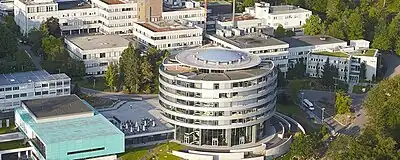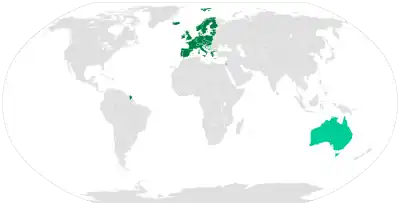 | |
| Established | 1974 |
|---|---|
| Director General | Edith Heard[1] |
| Faculty | ~95 |
| Location | |
| Website | www |
The European Molecular Biology Laboratory (EMBL) is an intergovernmental organization dedicated to molecular biology research and is supported by 29 member states, one prospect state, and one associate member state.[2] EMBL was created in 1974 and is funded by public research money from its member states.[3] Research at EMBL is conducted by approximately 110 independent research and service groups and teams covering the spectrum of molecular biology and bioinformatics. The list of Groups and Teams at EMBL can be found at www
History
EMBL was the idea of Leó Szilárd,[4] James Watson and John Kendrew.[5] Their goal was to create an international research centre, similar to CERN, to rival the strongly American-dominated field of molecular biology.[6] Kendrew served as the first Director-general of EMBL until 1982 and was succeeded by Lennart Philipson.[7][8][9] From 1993 to 2005, Fotis Kafatos,[10][11] served as director and was succeeded by Iain Mattaj, EMBL's fourth director, from 2005 to 2018.[12] In January 2019, Edith Heard became the fifth director of EMBL and the first woman to hold this position.[1]

Heard announced the organisation's five-year scientific programme Molecules to Ecosystems on 19 January 2022.
Research

Each EMBL site has a specific research field. The EMBL-EBI is a hub for bioinformatics research and services, developing and maintaining a large number of scientific databases that are free of charge. At Grenoble and Hamburg, research is focused on structural biology.

The EMBL Rome site is dedicated to the study of epigenetics and neurobiology. Scientists at EMBL Barcelona are exploring how tissues and organs function and develop, in health and disease.[13] At the headquarters in Heidelberg, there are units in cell biology and biophysics, developmental biology, genome biology, and structural and computational biology, as well as service groups complementing the aforementioned research fields.
Many scientific breakthroughs have been made at EMBL. The first systematic genetic analysis of embryonic development in the fruit fly was conducted at EMBL by Christiane Nüsslein-Volhard and Eric Wieschaus,[14] for which they were awarded the Nobel Prize in Physiology or Medicine in 1995. In the early 1980s, Jacques Dubochet and his team at EMBL developed cryogenic electron microscopy for biological structures. They were rewarded with the 2017 Nobel Prize in Chemistry.

Scientific Services
EMBL has identified as a core mission the provision of advanced experimental and data services to external researchers, including structural biology, imaging and sequencing facilities at its five European sites. In 2021, EMBL completed a new centre for high-resolution light and electron microscopy at its Heidelberg Headquarters – the EMBL Imaging Centre. The centre is open to visiting scientists worldwide and provides a unique service facility for the life sciences by combining the latest imaging technologies with expert advice and industry-led developments not yet otherwise available.[15]
Training

Advanced training is one of EMBL's five core missions.[16] Over the years, the Laboratory has established a number of training activities, of which the EMBL International PhD Programme (EIPP) is the flagship – it has a student body of about 200, and since 1997 has had the right to award its own degree, although currently students receive their degrees from partner universities. Other activities include the postdoctoral programme, including the EMBL Interdisciplinary Postdoctoral programme (EIPOD) and the Visitor Programme.[17]
EMBL Advanced Training Centre
In March 2010, the EMBL Advanced Training Centre (ATC) was inaugurated on the main campus in Heidelberg. Shaped in the form of a double helix,[18] it hosts scientific conferences, seminars and training courses, and provides access to training laboratories and lecture halls.[19]
The ATC also hosts EMBL's European Learning Lab for the Life Sciences (ELLS) which provides training for secondary school teachers on the latest developments in molecular biology, and runs a student outreach program.
Science and society
EMBL also runs an active Science and Society Programme which offers activities and events on current questions in life science research for the general public and the scientific community.[20]
Membership


EMBL is currently supported by 29 member states, one associate member state, and two prospect member states.
| Member states[2] | Year of joining |
|---|---|
| 1974 | |
| 1990 | |
| 2006 | |
| 2014 | |
| 1974 | |
| 2023 | |
| 1984 | |
| 1974 | |
| 1974 | |
| 1984 | |
| 2017 | |
| 2005 | |
| 2003 | |
| 1974 | |
| 1974 | |
| 2024 | |
| 2019 | |
| 2007 | |
| 2016 | |
| 2018 | |
| 1974 | |
| 1985 | |
| 2019 | |
| 1998 | |
| 2018 | |
| 1986 | |
| 1974 | |
| 1974 | |
| 1974 | |
| Prospect Member State | |
| 2023 | |
| Associate Member States | |
| 2014 - 2020 | |
| 2008 | |
See also
Notes and references
- 1 2 Noyes, Dan (28 June 2017). "EMBL Council selects next Director General". EMBL etc.
- 1 2 "EMBL member states". European Molecular Biology Laboratory. 2021.
- ↑ Signing of the agreement to set up a European molecular biology research laboratory. CERN. 10 May 1973.
- ↑ Maas, W; Crow, J. F. (2004). "Leo Szilard: A personal remembrance". Genetics. 167 (2): 555–8. doi:10.1534/genetics.104.030320. PMC 1470899. PMID 15238510.
- ↑ Holmes, K. C. (2001). "Sir John Cowdery Kendrew. 24 March 1917 - 23 August 1997: Elected F.R.S. 1960". Biographical Memoirs of Fellows of the Royal Society. 47: 311–332. doi:10.1098/rsbm.2001.0018. PMID 15124647.
- ↑ "EMBL History". 2015. Archived from the original on 13 April 2014.
- ↑ Pettersson, U (2011). "Lennart Philipson: A fighter is gone". Proceedings of the National Academy of Sciences. 108 (47): 18875. Bibcode:2011PNAS..10818875P. doi:10.1073/pnas.1116859108. PMC 3223467. PMID 22106290.
- ↑ Simons, K.; Mattaj, I. W. (2011). "Lennart Philipson (1929-2011)". Science. 333 (6043): 711. Bibcode:2011Sci...333..711S. doi:10.1126/science.1210990. PMID 21817041. S2CID 10083044.
- ↑ Baltimore, D. (2011). "Lennart Philipson (1929–2011): A Warrior Has Passed". PLOS Biology. 9 (9): e1001153. doi:10.1371/journal.pbio.1001153. PMC 3176751.
- ↑ Gilbert, N. (2010). "The labours of Fotis Kafatos". Nature. 464 (7285): 20. doi:10.1038/464020a. PMID 20203577.
- ↑ Kafatos, F. (2008). "Straight talk with...Fotis Kafatos". Nature Medicine. 14 (9): 902–903. doi:10.1038/nm0908-902. PMID 18776875. S2CID 21218047.
- ↑ "MATTAJ, Iain William". Who's Who. Vol. 2015 (online Oxford University Press ed.). A & C Black. (Subscription or UK public library membership required.)
- ↑ "About EMBL | EMBL.org".
- ↑ Nüsslein-Volhard, C.; Wieschaus, E. (1980). "Mutations affecting segment number and polarity in Drosophila". Nature. 287 (5785): 795–801. Bibcode:1980Natur.287..795N. doi:10.1038/287795a0. PMID 6776413. S2CID 4337658.
- ↑ "Funding agreed for imaging technology centre at EMBL Heidelberg". 31 August 2017.
- ↑ "Missions | EMBL.org".
- ↑ Training at EMBL, EMBL website
- ↑ "University of Heidelberg – Press Releases". Archived from the original on 4 March 2016. Retrieved 6 June 2014.
- ↑ "Conferences and Courses". EMBL. 2020. Retrieved 7 June 2020.
- ↑ Science and Society Programme, EMBL website